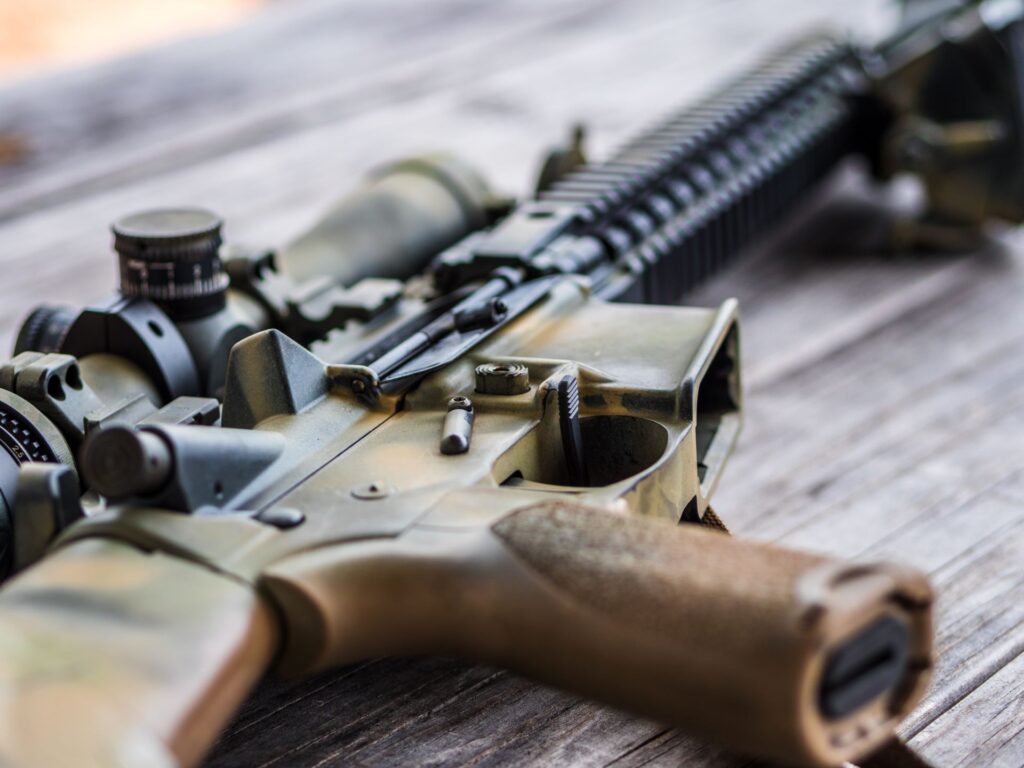Corrosion can significantly compromise the performance and lifespan of firearms. For AR-15 enthusiasts who face harsh environments or simply wish to enhance the longevity and reliability of their rifles, building or modifying a firearm to be corrosion-resistant is a critical measure. This detailed guide will cover the necessary steps and considerations to either construct a corrosion-resistant AR-15 from scratch or modify an existing one.
The Importance of Corrosion Resistance
Corrosion resistance is vital for the AR-15, as it fundamentally ensures the rifle’s durability and reliability across a variety of environmental conditions. The importance of this characteristic stems from the potential for corrosion to significantly impair the firearm’s performance and safety. When the metal components of the AR-15 are exposed to elements like moisture, salt, and acids, they can undergo processes such as rusting and pitting. These processes not only degrade the material physically, leading to visible wear and damage, but also weaken the structural integrity of the firearm, which can result in mechanical failures during operation. Corrosive resistance in rifles is not the end-all to maintenance, but it sure will keep your rifle usable far longer in less-than-desirable conditions.

For an AR-15, maintaining corrosion resistance is crucial because it:
- Prevents Functionality Loss: Corrosion can seize moving parts and erode the interfaces between components, which are essential for the smooth operation of the firearm.
- Ensures Safety: Structural integrity is paramount in firearms; weakened components due to corrosion could fail unexpectedly under stress, posing serious safety risks.
- Extends Lifespan: By resisting corrosion, the lifespan of the firearm is significantly extended, maintaining its value and effectiveness as a long-term investment.
- Enhances Reliability: A corrosion-resistant AR-15 remains reliable in adverse conditions, which is essential for users who rely on their firearm for defense, law enforcement, hunting, or competitive shooting.
When You’d Need It
- Marine patrols: Essential for handling saltwater exposure, especially on open decks.
- Backcountry hunting: Important in humid, rainy regions like the Pacific Northwest.
- Winter deer stands: Prevents rust from snow and melting ice in colder climates.
- Beachside properties: For home defense in areas with salty, ocean air.
- Flood rescue operations: Useful in emergency response situations in flooded areas.
- Swamp excursions: Needed in muggy, wet areas with lots of vegetation and water.
- Desert patrols: Protects against the corrosive effects of sand and arid, salty air.
- Tropical jungle adventures: Helps in humid, dense jungle environments where moisture is omnipresent.
- Industrial security: Useful in areas with chemical pollutants and variable weather conditions.

Building a Corrosion-Resistant AR-15 from Scratch
Step 1: Selection of Materials
Frame and Body:
- Aluminum Alloys: Aluminum remains the preferred choice for the body of an AR-15 due to its combination of lightness and strength. Among aluminum alloys, 7075-T6 is particularly valued for its high zinc content, which significantly enhances its corrosion resistance. This alloy, primarily used in aerospace applications, offers a superior strength-to-weight ratio. The anodizing process it undergoes is crucial; it involves an electrochemical procedure that converts the metal surface into a durable, corrosion-resistant, anodic oxide finish. This finish not only protects the aluminum from the elements but also prepares it for further coatings, such as Cerakote, which can further enhance its durability and aesthetic appeal.
- Alternative Metals: For builders who prioritize ultimate durability over weight and cost considerations, titanium and stainless steel present excellent alternatives. Titanium, known for its exceptional strength and corrosion resistance, makes for an outstanding choice in environments where the rifle may be exposed to highly corrosive elements like saltwater. Stainless steel, while heavier, provides robust resistance against rust and corrosion without the need for additional coatings, making it an ideal material for parts that undergo high stress and exposure, such as the lower receiver.
Barrel:
- Stainless Steel: The choice of stainless steel for the barrel is crucial for long-term reliability and performance. The 416R stainless steel grade is specifically designed for precision firearms applications. It combines corrosion resistance with excellent machinability, allowing for tight tolerances and smooth bores that are essential for accuracy. Its resistance to heat and friction makes it an ideal choice for high-rate firing scenarios.
- Coating Options: Beyond material selection, surface treatments such as Melonite or other nitriding processes play a pivotal role in enhancing barrel life and performance. These treatments involve the diffusion of nitrogen and carbon into the surface of the steel, creating a hard, wear-resistant layer that is incredibly effective at resisting corrosion and reducing friction. This not only extends the barrel’s life, but also maintains its accuracy over longer periods and under harsh conditions.

Step 2: Choosing Corrosion-Resistant Components
Internal Components:
- Bolt Carrier Group (BCG): The BCG is critical to the rifle’s operation, and choosing the right materials and parts is essential. Nickel-boron and titanium-nitride coatings are excellent choices as they offer superior corrosion resistance, reduced friction, and easier cleaning. These materials ensure that the BCG operates smoothly under any conditions, enhancing the overall reliability and lifespan of the firearm.
- Trigger Assembly: The trigger assembly must offer both reliability and resistance to environmental challenges. Stainless steel triggers provide inherent corrosion resistance, while additional chrome coating can further ensure that the trigger maintains its integrity and smooth operation even when exposed to moisture and debris.
External Components:
- Stocks and Grips: Choosing the right materials for stocks and grips can indirectly influence the corrosion resistance of the entire firearm. Synthetic polymers are preferred for their ability to withstand environmental factors without absorbing moisture, which could otherwise seep into more vulnerable parts of the rifle. Ensuring a tight and precise fit of these components helps eliminate spaces where moisture and dirt might accumulate.
- Fasteners and Pins: Often neglected in terms of material quality, fasteners and pins should be selected with corrosion resistance in mind. Stainless steel or specially coated fasteners can prevent critical failures caused by rust and corrosion. These components may be small, but their role in maintaining the structural integrity of the AR-15 under adverse conditions is undeniable.
Step 3: Protective Coatings and Finishes
Cerakote Application:
- Preparation: Proper preparation is crucial for successful application of Cerakote. This includes complete disassembly of the rifle and thorough cleaning and degreasing of each part. Sandblasting the metal surfaces to a specific surface roughness ensures optimal adhesion of the cerakote.
- Application: Applying cerakote with an HVLP spray gun requires skill and attention to detail. The coating must be applied evenly and at the correct thickness to prevent inconsistencies that could affect the metal’s fatigue strength or create points of vulnerability.
- Curing: The curing process is essential to achieve the full protective potential of the Cerakote. Components are baked in a controlled oven environment, where the temperature and time must be precisely maintained to ensure the coating cures uniformly, bonding at a molecular level to create a durable, protective layer.

Modifying an Existing AR-15 for Enhanced Corrosion Resistance
Step 1: Assess and Disassemble
Begin by thoroughly inspecting your AR-15 for signs of wear or existing corrosion, especially in commonly overlooked areas such as under the gas block, around the barrel nut, and inside the lower receiver where the buffer rests. This detailed assessment helps in identifying the severity and location of any corrosion, informing your approach to modification.
Carefully disassemble your rifle, categorizing components to keep track of them and to ensure each part receives the necessary attention. Use this opportunity to clean each part with a high-quality solvent that prepares the surfaces for further treatments without leaving residues that could interact with new finishes.
Step 2: Replace or Treat Corrosion-Prone Components
Evaluate each component for material suitability and condition. Replace parts that are severely corroded and cannot be effectively restored. For parts with minimal wear, apply corrosion-resistant finishes:
- Barrel and BCG: If the barrel and bolt carrier group show early signs of rust, consider applying advanced surface treatments such as Melonite or Parkerizing. These treatments not only add a layer of protection but also enhance the hardness and durability of the surfaces.
- Small Components: Pay special attention to smaller, often neglected parts like the firing pin, bolt assembly, and trigger mechanism. These can benefit from nickel-boron or titanium-nitride coatings that reduce friction and prevent corrosion without significant changes to the geometry of the parts.
- External Metal Surfaces: Apply a Cerakote finish to the external surfaces of the upper and lower receivers and the handguard. Choose a Cerakote color that provides excellent coverage and corrosion resistance while also giving your AR-15 a custom look.

Step 3: Reassemble and Maintain
After all modifications are complete, reassemble your AR-15 with precision, ensuring that each component is correctly installed and securely fastened. Post-assembly, conduct a function test to ensure that all parts operate smoothly together.
Size
- Regular Cleaning: After every use, clean your AR-15 thoroughly to remove residues and moisture that can lead to corrosion. Use cleaners and lubricants that offer protective properties against rust.
- Periodic Inspection: Every few months, especially if stored for extended periods or after use in harsh conditions, inspect your AR-15 for any signs of new corrosion or wear. Pay special attention to newly coated or replaced parts to ensure their integrity.
- Storage: Store your firearm in a controlled environment where humidity and temperature are regulated to minimize the risk of corrosion. Use vapor corrosion inhibitors (VCI) in your storage case, which release compounds that actively prevent rust.
By following these detailed steps for modifying an existing AR-15 to enhance its corrosion resistance, you can ensure that your firearm remains reliable, safe, and durable across various environments.
Final Thoughts
Building or modifying an AR-15 to be corrosion-resistant involves careful selection of materials and components, application of protective finishes, and regular maintenance. This effort not only extends the life of your firearm but also enhances its reliability and safety under various environmental conditions. By following these detailed steps, you can ensure that your AR-15 remains a dependable tool for years to come.




